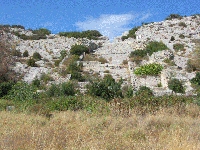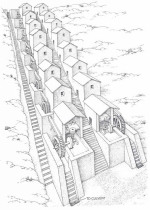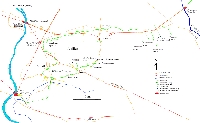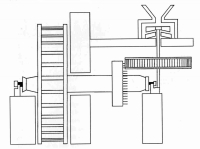



Roman Flour Mill
The Roman flour mill at Barbegal (France) is an example of something that, according to some experts, never existed: a Roman water-powered factory. According to contemporary classicist A. Trevor Hodge (p. 106),"Barbegal is significant because it calls into question what may be termed the 'technology theory' of the decline and fall of the Roman Empire. The theory maintains that the availability of cheap slave labor prevented the Romans from developing alternative sources of power, without which large scale manufacturing is impossible."
Twelve kilometers north of Arles, France, two aqueducts cross a local road. Springs from both sides of the Alpilles mountains were used to feed an aqueduct system of 62 km long. This system is complicated since it untill recently it was not clear how the waters of both sources was distributed between the city of Arles and the Barbagal grainmills. The aqueduct channels meet just north of the double aqueduct bridges in the so-called Vallon des Arcs. After crossing the valley one of the channels makes a 90 degree turn to provide drinking water to Roman community at Arelate, modern-day Arles, but the second proceeds straight, slicing through a solid rock outcrop. From the top of the outcrop, with a little imagination and a drawing from Scientific American, it was possible to interpret the rubble below.
Flour Mill
The concept was simple, but the application is impressive. Barbegal was an immense flour mill, dating from the 4th century A.D. The power to drive the millstones came from 16 waterwheels, arranged in two parallel rows of eight. Each row ran downhill so that the water dropped from one wheel to the next, driving all eight in turn before running into a drain at the foot of the hill. Near the top of the ridge is a sign dedicated to the man who first investigated the site in 1940, Fernand Benoit: "Thanks to his efforts we have a better understanding of the technological innovation of the Roman Empire." Contemporary evidence of multiple mills during the Roman era is rare.Hodges has made an attempt to estimate the productivity of the 16 flour mills. Using conservative estimates about the flow of water from the aqueduct, and assuming 50 percent downtime - to accommodate interruptions for maintenance, breakdowns, late arriving grain shipments, and other interferences - the mills could still produce enough flour to feed 12,500 individuals, the population of nearby Arelate (present-day Arles) in the 4th century A.D.
Other Roman Mills
There were at least two other multiple Roman mills, but neither was as ambitious as Barbegal. Chemtou in western Tunisia, and the other mill were in Israel on a dam on the Crocodile River near ancient Caesarea. According to Hodges (p. 111): "Neither installation has been fully studied, but together they remain the only known parallels to Barbegal." But he feels strongly that there are probably other Roman mills that remain to be discovered.Based on Roger D. Hansen from www.waterhistory.org
Reference: A. Trevor Hodge, "A Roman Factory," Scientific American (November, 1990), pp. 106-111.